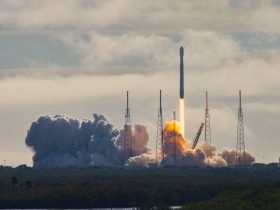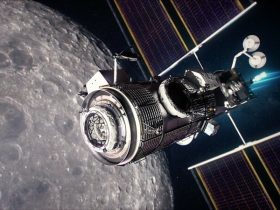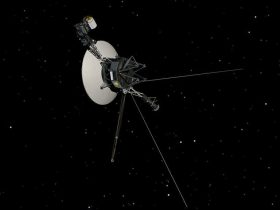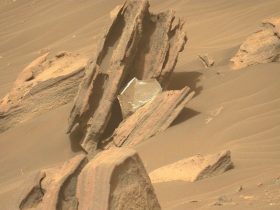A hefty query nonetheless puzzles planetary scientists: What occurred to Venus?
Although Venus and Earth are similarly-sized rocky worlds occupying comparable components of the photo voltaic system, Venus is a hellish land sizzling sufficient to soften lead. In the meantime, beautiful biodiversity prospers on temperate Earth. Someplace, their tales diverged.
Later this decade, NASA will launch its DAVINCI mission — quick for Deep Ambiance Venus Investigation of Noble gases, Chemistry, and Imaging — to gather unprecedented observations of our torrid sister planet. As specified by a brand new paper by mission researchers, the probe will assist reply elusive questions: Did Venus harbor oceans? Was it liveable? What, precisely, is occurring on its floor?
“Venus has all the time been this enigmatic sister planet.”
On a Venusian day in 2031, at excessive midday, the DAVINCI spacecraft will drop a three-foot-wide titanium sphere by way of Venus’ thick clouds. It would ingest gases. It would run experiments. It would endure extremes of warmth and strain. It would present us what Venusian mountains truly appear to be. If all goes as deliberate, only a single hour of observations will rework our understanding of Venus.
“Venus has all the time been this enigmatic sister planet,” Jim Garvin, who leads NASA’s DAVINCI mission, advised Mashable. “Why does not Venus appear to be Earth?” he wonders.

The plummet by way of Venus’ clouds
It is not simple to see into, nor perceive, Venus.
The planet’s clouds are some 19 miles (30 kilometers) thick, which largely shroud the world under. Within the early Nineties, NASA’s Magellan orbiter used a cloud-penetrating radar to map a very good portion of Venus’ floor, which found lava flows, mountains, craters, and past. However nonetheless, our grasp of this dynamic world is “fuzzy,” Garvin mentioned. A number of Soviet probes landed on the floor within the Seventies and Eighties and returned again the one footage ever captured from Venus’ floor. However below crushing strain and warmth, these machines by no means survived for even two hours. (The floor strain on Venus is 90 instances that on Earth, or about the identical strain 1 mile beneath the ocean.)
Engineers aren’t constructing the DAVINCI probe to outlive for rather more than an hour because it drops by way of Venus’ clouds, after which hits the floor at some 25 mph. However even a brief journey calls for a sturdy spacecraft. It is a sphere of titanium, one of many strongest metals on Earth. Past withstanding intense strain and searing warmth, the craft and its science devices should endure acidic clouds.
“It is a comparatively tranquil fall.”
As DAVINCI drops by way of the ambiance, it’s going to make hundreds of observations. The probe will measure the air strain and temperature each fifty toes; it’s going to inhale and establish completely different gases; it’s going to run experiments aboard the sphere, equivalent to analyzing telltale chemical substances that may show liquid water as soon as existed or flowed on the planet (it actually does not anymore). “We’re bringing the lab to Venus,” Garvin mentioned.
The plummeting probe has an especially packed 60 minute-itinerary because it falls by way of the ambiance, which it enters at some 120 kilometers, or 75 miles, above the floor.
- At 70 kilometers (44 miles): The probe will jettison its protecting warmth defend. The probe will then launch a parachute and begin dropping gently by way of the Venusian sky, held on by heat-resistant Kevlar cables. It would ingest and analyze gases, and beam this info as much as the DAVINCI relay spacecraft orbiting above the planet (this craft carried the probe to Venus, after which dropped it into the clouds).
- At 40 kilometers (25 miles): The probe ditches its parachute. It is now gently free-falling by way of the thick ambiance like a stone in water, at some 25 mph. “It is a comparatively tranquil fall,” Garvin defined. The probe will proceed to ingest gases and beam that knowledge as much as the spacecraft above.
- At 10 kilometers (six miles): The probe will enter a zone of immensely dense strain, the place the carbon dioxide ambiance is simply twelve instances much less dense than water. The views will nonetheless be foggy, however DAVINCI’s specialised cameras will establish completely different rock sorts under.
- At 1.5 kilometers (a few mile): The views will probably be superb. The probe will descend to the mountains within the rugged Alpha Regio area. “We’ll have clear pictures of the mountains of Venus for the very first time,” Garvin marveled.
- Touchdown: The mission is over by the point the probe thunks down on Venus’ floor. The titanium probe, baking in 900-degree Fahrenheit temperatures, might last as long as 17 minutes, nonetheless amassing info on the mysterious Venusian floor.

Venus-like worlds
There are probably over 1 trillion exoplanets, or planets past our photo voltaic system, within the Milky Approach galaxy alone. And most of the smaller, Earth-sized planets could also be much like Venus. These are “exo-Venuses,” if you’ll.
The brand new James Webb Area Telescope — essentially the most highly effective such telescope ever constructed — will quickly deal with exoplanets in our galaxy, and researchers would possibly discover many Venus-like worlds (these planets will be shiny and reflective, they usually’re additionally near their respective stars, making them simpler to identify as they transit by). Crucially, if planetary scientists wish to higher perceive these Venus-like worlds — in the event that they’re liveable or in the event that they harbor oceans like Venus as soon as may need — they should higher perceive the precise Venus subsequent door, which comes as shut as 38 million miles from Earth.
“We have now to know our Venus.”
“We have now to know our Venus,” emphasised Garvin.
Some simulations of Venus’ evolution predicted it had an ocean for some 2 or 3 billion years. That is a number of time for potential life to evolve. Out within the deeper cosmos, different exo-Venuses would possibly harbor comparable environments.
However first, planetary scientists should grasp extra about Venus’ historical past. The hardy DAVINCI probe will decide up clues about previous water, and past, on the planet. We have seen many pictures of the cloud-shrouded Venus, however perceive little of what lies, and as soon as existed, under.
“We have not seen something but,” Garvin mentioned.









